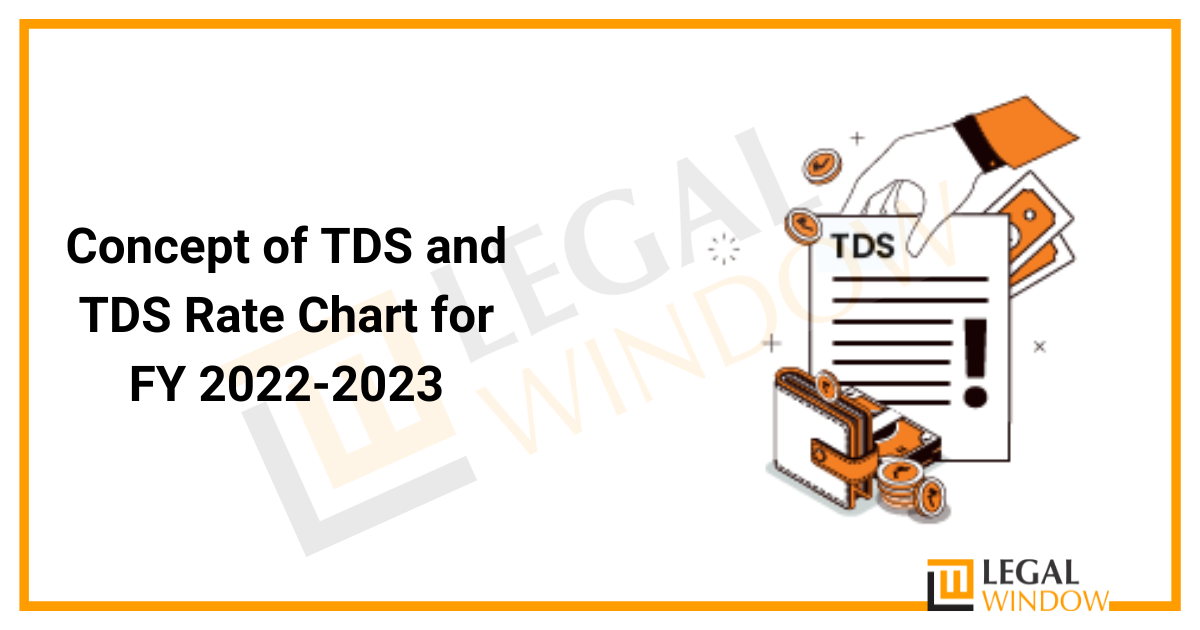
It is not easy to handle such a Huge yet Amazing country like India, where diversity between cultures, religions, Class can be seen clearly. The government of India, in its day-to-day routine, has been experimenting with new Ideas to generate different revenue sources for the country. We cannot deny that in doing so, our democratized government have got success; one such source revenue-generating instrument of government is Tax Deducted at Source or commonly referred to as “TDS”. Let us delve into this concept in great detail and we’ll also look into TDS Rate Chart for FY 2022-2023.
| Table of Content |
Short Glimpse
Every Year Government of India releases its various Tax Rates applicable to the citizens of the country, for the better functioning of the country and to collect tax from the very source of revenue, the TDS idea was established. According to this concept, a person (deductor) who is required to make a payment of a certain sort to another person (deductee) must withhold tax at source and deposit it into the Central Government’s account. Based on Form 26AS or a TDS certificate provided by the deductor, the deductee from whose income tax source deductions have been made is entitled to get credit for the amount so deducted.
The TDS on payment for the transfer of virtual digital assets, the TDS on the sale of movable property (higher of the stamp duty valuation and sales consideration), the higher TDS rates for non-filers of ITR (reduced 1 year), and the TDS on benefits or perquisites of a business or profession are the major changes proposed in the Budget 2022.
Before we shall delve into our topic of concern, we must discuss first TDS, so that we could have a better understanding of this concept.
Concept of Tax Deducted at Source
A system known as Tax Deducted at Source (TDS) was instituted by the Income Tax Department. Under this system, the person in charge of making certain payments, such as salaries, commissions, professional fees, interest, rent, etc., is required to withhold a specific amount of tax before making the full payment to the recipient of the payment. The idea of TDS is to deduct tax at the source, as the name implies. TDS delivers consistent income for the government while easing the burden of tax filing for the deductee.
Isn’t it amazing how, our rulers have incorporated this concept of TDS for revenue generation, now, let us discuss by whom TDS is deducted?
When and by whom TDS is deducted?
The deduction of TDS depends upon the following factors:
- Any payment that fits the description in the Income Tax Act, 1961 will have TDS taken off at the time of the transaction.
- No TDS will be taken from your income whether you are an individual or a Hindu Undivided Family (HUF), and your records won’t be audited.
- Though you pay rent as an individual or as a member of a HUF and the amount payable exceeds Rs. 50 000, a TDS of 5% will be levied even if your books are not the subject of a tax audit.
- You won’t need to apply for a Tax Deduction Account Number if you need TDS deducted at a rate of 5%. (TAN).
- If you have a job, your employer will take TDS deductions based on your income tax slab rates.
- The bank with whom you have a working account will withhold TDS at a rate of 10%. If they do not have your PAN information, TDS at a rate of 20% will be taken.
- For the bulk of payments, TDS rates are established by the Income Tax Act, and the payer deducts TDS from the rates.
- You won’t be required to pay any tax if you provide your employer with investment evidence and your total taxable income is below the total taxable level. Therefore, no TDS will be taken into account in this scenario.
- You can also give the bank Forms 15G and 15H if your total taxable income is below the total taxable limit. The bank won’t deduct any TDS from your interest profits in this situation.
- If the bank withheld the TDS because you failed to provide your employer with the investment evidence, you can submit a return and receive a refund if your total taxable income is less than the total taxable limit.
TDS’s Benefits and Merits
The essence of TDS is the concept of “pay as and when you earn.” TDS is a situation in which the taxpayers and the government both benefit. When paying with cash, credit, or a check, tax is subtracted and deposited with the central authorities.
Merits of TDS: The following are the merits of TDS:
- It stops individuals from evading paying taxes.
- TDS is a reliable stream of funding for the government.
- The automated deduction of the necessary tax amount makes it more comfortable for the deductee.
Don’t forget to read our Articles on TDS under Section 194Q of the Income Tax Act, 1961, and Guide to new TDS Section 194R of the Income Tax Act, 1961, for better and updated knowledge on TDS.
TDS Certificate and claiming of TDS
On the IRS website, anyone can submit a TDS refund application. The individual must, however, file their Income Tax Returns and request their TDS refund. After the taxpayer files the ITR, the Income Tax Department will process the TDS. Within six months, the bank will credit the money. On the official website of the Internal Revenue Service, customers may also track the progress of their refund.
TDS Certificate: TDS certifications come in two different formats:
- Form 16 and
- Form 16A
By Section 203 of the Income Tax Act, 1961, the department must issue a certificate to the deductee. The deductor is required to give this form to the deducted. Salaried employees must receive Form 16 from their employers, which must provide a breakdown of the TDS deductions made. Form 16 includes the tax computation, the tax deduction, and the payment of TDS. By May 31 of the next fiscal year, employers must give this form to their staff members.
The deductor provides Form 16A for non-salaried classes, which contains details on computation, TDS deduction, and payments.
Legal Window will assist you in timely filing your TDS Return so that your employee and others from whom TDS has been deducted may complete their form 26AS with the correct information. For TDS Working, contact our staff at 072407-51000 or by email at admin@legalwindow.in.
TDS Rate Chart for FY 2022-2023
TDS Rate Chart for FY 2022-2023 is as follows:
| Section | Nature of Payment | Threshold (Rs.) | Individual / HUF TDS Rates (%) | Others TDS Rate (%) |
| 192 | Salaries | Rs. 2,50,000 | Slab Rates | Slab Rates |
| 192A | Premature EPF withdrawal | Rs. 50,000 | 10% | 10% |
| 193 | Government securities interest | Rs. 10,000 | 10% | 10% |
| 194 | Payment of dividend | Rs. 5,000 | 10% | 10% |
| 194A | Interest by banks or post offices on deposits | Rs. 40,000 Rs. 50,000 (For senior citizens) |
10% | 10% |
| 194A | Interest by others apart from on securities | Rs. 5,000 | 10% | 10% |
| 194B | Amount won through lotteries, puzzles, or games | Rs. 10,000 | 30% | 30% |
| 194BB | Amount won from horse races | Rs. 10,000 | 30% | 30% |
| 194C | Payments to contractor or sub-contractor – Single Payments | Rs. 30,000 | 1% | 2% |
| 194C | Payments to contractor/sub-contractor – Aggregate Payments | Rs. 1,00,000 | 1% | 2% |
| 194D | Payment of insurance commission to domestic companies | Rs. 15,000 | NA | 10% |
| 194D | Payment of insurance commission to companies other than domestic | Rs. 15,000 | 5% | NA |
| 194DA | Maturity of Life Insurance Policy | Rs. 1,00,000 | 5% | 5% |
| 194EE | Payment of an amount standing to the credit of an individual under NSS (National Savings Scheme) | Rs. 2500 | 10% | 10% |
| 194F | Payment of repurchase of the unit by UTI (Unit Trust of India) or any mutual fund | No Limit | 20% | 20% |
| 194G | Payments or commissions on the sale of lottery tickets | Rs. 15,000 | 5% | 5% |
| 194H | Commission or brokerage | Rs. 15,000 | 5% | 5% |
| 194I | Rent of land, building, or furniture | Rs. 2,40,000 | 10% | 10% |
| 194I | Rent of plant and machinery | Rs. 2,40,000 | 2% | 2% |
| 194IA | Payment for transfer of immovable property other than agricultural land | Rs. 50,00,000 | 1% | 1% |
| 194IB | Rent payment that is made by an individual or HUF not covered under payment 194I | Rs. 50,000 (per month) | 5% | NA |
| 194IC | Payment made under Joint Development Agreement (JDA) to Individual/HUF | No Limit | 10% | 10% |
| 194J | Fees paid for professional services | Rs. 30,000 | 10% | 10% |
| 194J | Amount paid for technical services | Rs. 30,000 | 2% | 2% |
| 194J | Amounts paid as royalty: sale/distribution/exhibition of cinematographic films | Rs. 30,000 | 2% | 2% |
| 194K | Payment of income for units of a mutual fund, for example- dividends | Rs. 5,000 | 10% | 10% |
| 194LA | Payment for compensation for acquiring certain immovable property | Rs. 2,50,000 | 10% | 10% |
| 194LB | Payment of interest on infrastructure bonds to Non-Resident Indians | NA | 5% | 5% |
| 194LBA(1) | Certain income distributed by a business trust among its unit holder | NA | 10% | 10% |
| 194LD | Payment of interest on rupee-denominated bonds, municipal debt security, and government securities | NA | 5% | 5% |
| 194M | Amounts paid for the contract, brokerage, commission, or professional fee (other than 194C, 194H, 194J) | Rs. 50,00,000 | 5% | 5% |
| 194N | In case cash withdrawal over a certain amount takes place from the bank, and ITR is filed | Rs. 1,00,00,000 | 2% | 2% |
| 194N | In case cash withdrawal takes place from a bank and one does not file ITR | Rs. 20,00,000 | 2% | 2% |
| 194O | Amount paid for the sale of products/services by e-commerce service providers via their digital platform | Rs. 5,00,000 | 1% | 1% |
| 194Q | Payments made for the purchase of goods | Rs. 50,00,000 | 0.10% | 0.10% |
| 194S | TDS on the payment of any crypto or other virtual asset | NA | 1% | 1% |
| 206AA | TDS for non-availability of PAN | NA | At a rate higher of
Specified rate as per the act 20% Rate in force |
|
| 206AB | TDS on non-filers of Income tax return | NA | Rate higher of:
5% Twice the mentioned rate in the provision Rate in force |
Penalty for Late Payment of TDS
The Income Tax Department applies the following penalties for failure to submit or delays in filing your TDS return or statements:
- Under Section 272A (2) of the Income Tax Act, a penalty of Rs. 100 would be assessed for each day that the returns are not filed, up to the TDS amount.
- Section 234E of the Income Tax Act imposes a penalty of Rs. 200 for each day that the returns are not filed, up to the TDS amount.
- Section 271H of the Income Tax Act imposes a penalty of between Rs. 10,000 and Rs. 1 lakh if the deductor fails to file the TDS return by the due date.
- If the deductor gives inaccurate information about the PAN, the amount of TDS, etc. According to Section 271H of the Income Tax Act, there would be a fine of between Rs. 10,000 and Rs. 1 lakh.
- If the taxpayer fails to pay the TDS by the deadline, interest will also be assessed in addition to the fine.
- If any or all of the tax is not withheld at source, 1.5 percent interest per month will be charged starting on the day the tax was deductible and continuing until the day the tax is withheld.
Takeaway
The phenomenon of TDS is used to lessen the possibility of income recipient avoidance. Additionally, the country’s economy might become more transparent. A deductee’s tax filing burden is lessened thanks to Tax Deducted at Source. It guarantees that the government will get consistent tax income.
We are sure enough that this article has succeeded in explaining the TDS, in case you further counter any issue, connect to us at Legal Window.
CA Pulkit Goyal, is a fellow member of the Institute of Chartered Accountants of India (ICAI) having 10 years of experience in the profession of Chartered Accountancy and thorough understanding of the corporate as well as non-corporate entities taxation system. His core area of practice is foreign company taxation which has given him an edge in analytical thinking & executing assignments with a unique perspective. He has worked as a consultant with professionally managed corporates. He has experience of writing in different areas and keep at pace with the latest changes and analyze the different implications of various provisions of the act.
Categories
- Agreement Drafting (23)
- Annual Compliance (11)
- Change in Business (36)
- Company Law (148)
- Compliance (90)
- Digital Banking (3)
- Drug License (3)
- FEMA (17)
- Finance Company (42)
- Foreign Taxation (6)
- FSSAI License/Registration (14)
- GST (118)
- Hallmark Registration (1)
- Income Tax (200)
- Latest News (34)
- Miscellaneous (164)
- NBFC Registration (8)
- NGO (14)
- SEBI Registration (6)
- Section 8 Company (7)
- Start and manage a business (21)
- Startup/ Registration (128)
- Trademark Registration/IPR (40)
Recent Posts
- Post incorporation compliances for companies in India April 30, 2024
- Startup’s Guide to Employee Stock Ownership Plans April 29, 2024
- Master Secretarial Audit: A Complete Compliance Guide April 27, 2024
About us
LegalWindow.in is a professional technology driven platform of multidisciplined experts like CA/CS/Lawyers spanning with an aim to provide concrete solution to individuals, start-ups and other business organisation by maximising their growth at an affordable cost.









